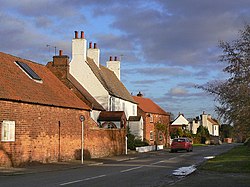Screveton
| Screveton | |
| Nottinghamshire | |
|---|---|
 Hawksworth Road, Screveton | |
| Location | |
| Grid reference: | SK732437 |
| Location: | 52°59’7"N, -0°54’42"W |
| Data | |
| Population: | 191 (2011) |
| Post town: | Nottingham |
| Postcode: | NG13 |
| Dialling code: | 01949 |
| Local Government | |
| Council: | Rushcliffe |
| Parliamentary constituency: |
Newark |
Screveton is a village in Nottinghamshire, in Bingham Wapentake. It has with about 190 inhabitants (including Kneeton) at the 2011 Census and is adjacent to Kneeton, Flintham, Hawksworth, Scarrington, Little Green and Car Colston.
Name
Screveton may contain the Old English word scir gerefa; 'sheriff', who in those days was the king's chief officer in the shire, so probably "Sheriff's farm/settlement".[1][2]
Heritage
Richard Whalley, who died at the old hall in Screveton in 1583, had been elected to Parliament four times in the troubled Tudor period. His three successive wives bore him a total of 25 children. A fine monument to him in the parish church bears an inscription:
"Behold his Wives were number three:
Two of them died in right good fame:
The Third this Tomb erected she,
For him who well deserv'd the same.
Both for his life and Godly end,
Which all that knows must needs commend:
And they that knows not, yet may see,
A worthy Whalleye loe was he.
Since time brings all things to an end,
Let us our selves applye,
And learn by this our faithful friend,
That here in Tombe doth lye,
To fear the Lord, and eke beholde
The fairest is but dust and Mold:
For as we are, so once was he:
And as he ys, so must we be."
The hall was demolished in the 1820s.[3] The population of the village at the beginning of the 1870s was 241 in 60 houses. The main landowners at that time were the politicians Sydney Pierrepont, 3rd Earl Manvers, and Thomas Thoroton-Hildyard, a descendant of the 17th-century local historian Robert Thoroton.[4] Two young men from Screveton who died for their country in the First World War are remembered on a memorial stone in the village churchyard.[5]
Church
The parish church, St Wilfrid's Church, Screveton. The church dates from the 13th century. The west tower, however, dates from the 15th century and was altered in the late 16th century. The chancel was restored in 1881, and the nave restored and vestry built in 1884. The alabaster tomb of one Richard Whalley bears carvings of his three consecutive wives and his 24 children.[6] It is a Grade I listed building.[7]
It forms a joint parish with St Mary's Church in Car Colston.
Two former Methodist chapels in the village are now residences, but there is still an active Methodist church at Scarrington, two and a half miles away.
Listed buildings
Other interesting buildings in the village include the Old Priest's House,[8] Top Farmhouse and adjacent buildings, and the circular pinfold,[9] whose unusual shape is also found in pounds at Scarrington and Flintham.
Outside links
| ("Wikimedia Commons" has material about Screveton) |
References
- ↑ Gover, J. E. B.; Mawer, A. & Stenton, F.M.: 'Place-Names of Nottinghamshire , Part' (English Place-Names Society, 1940), page 229
- ↑ Ekwall, Eilert, The Concise Oxford Dictionary of English Place-Names. Oxford, Oxford University Press, 4th edition, 1960. p. 409 ISBN 0198691033
- ↑ Brown, Cornelius: 'A History of Nottinghamshire' (1896)
- ↑ A Vision of Britain through Time Retrieved 14 January 2016.
- ↑ Screveton St Wilfrid War Memorial Retrieved 14 January 2016.
- ↑ Screveton: St Wilfred Retrieved 9 January 2018.
- ↑ National Heritage List 1243811: Church of St Wilfred (Grade I listing)
- ↑ National Heritage List 1243813: The Old Priest's House (Grade II listing)
- ↑ National Heritage List 1243814: The Pinfold (Grade II listing)
- Manuscripts and Special Collections (University of Nottingham):
